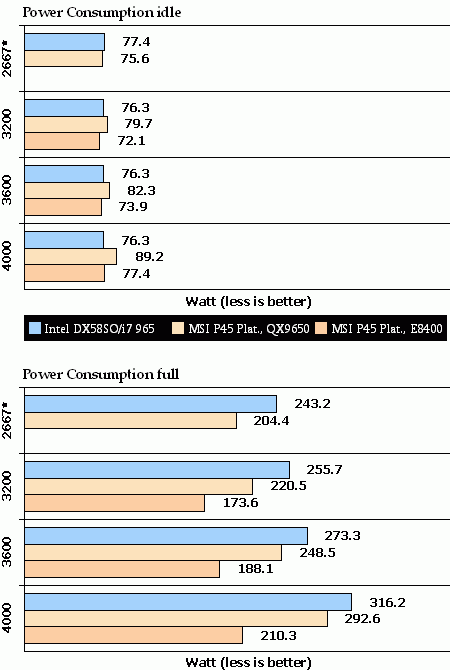Index
Page 9 of 9
Power Consumption:
While in most cases the new Core i7 CPUs are faster, they keep power consumption in check. Calculated by performance by wattage the i7 wins. The CPU does load more cores due to Hyperthreading enabled.
For unknown reasons the 920 needs a bit more in idle, compared to the 965XE which does great on idle-power through all speeds because we used only the dynamic overvoltage feature of the Intel board which keeps stock voltages nominal. We have no idea if any other vendor has the same feature, but we guess time will tell.
The "full" load does include two cores for x264, one core for superpi and the rest for 3DMark06. Of course we could have loaded the i7 more, but consider there are not many applications available which will force all "eight" CPUs with high graphics-card load. So, we think this is quite suitable. This results do not reflect the speed advantage of the CPU, we will do a more comprehensive test in our Games Special, where we will have FPS vs power consumption.

Conclusion:
While Intel had no need to bring a faster CPU in the desktop market, the new CPUs are quite promising and the speed increase impressive. They are the fastest CPU you can buy, but while the 920 is quite "cheap" at under €300, you have to change your whole platform. Board prices start now at about €220 up to €350, so you have to even pay more for a board than your CPU, which is quite odd.
Also the cheapest 3GB PC3-8500 CL7 kits will cost you about €120; 6GB starts at €200 where a 4GB DDR2 kit can be bought for roughly €35, which is insane.
So even when you consider the smallest of the Core i7 CPUs "cheap", the whole system will cost you a fortune and the better performance does not justify the cost for everyday users or gamers. If you use your computer for commercial rendering the cost will be justified by the time-savings you can achive. We doubt a professional Photoshop user can do it, because most plugins are only optimized for two cores, Otherwise, there is no need to upgrade as long as your system costs three times more, compared to a standard DDR2 system.
We will have to wait for next year, when the Core i7 Dual Core CPUs in the LGA1156 socket arrive. The boards for it should be cheaper because you won't need a six-layer PCB due to fact this CPUs will "only" feature a dual-channel memory interface, besides OEM demand will reduce DDR3 costs.
Sadly, with the two-socket policy there is no question of upgrading, either you want two cores with four threads or you want four cores with eight threads. In our opinion Intel could have achived the differentiation between workstation and normal user by introducing new Xeons first and skipping the "core" madness. We predict that even in two years there will be hardly any application for the masses which will benefit from eight threads at all.
« Prev Next
